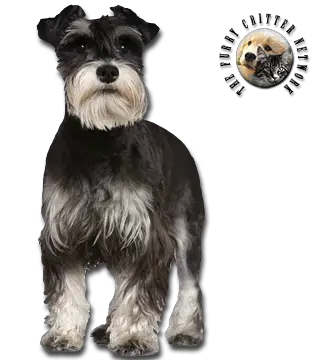Breed Standard
Head: Strong, elongated. Pronounced stop. Rectangular nose bridge. Shaggy muzzle ending in a blunt wedge. Black lips.
Ears: If cropped, carried erect. If natural, v-shaped, breaking at skull level or small and held erect.
Eyes: Oval. Dark color.
Body: Square outline. Arched neck. Medium width chest with moderately sprung ribs. Belly moderately tucked up. Short back sloping gently toward the croup.
Tail: Set high and carried erect. Docked to three vertebrae.
Hair: Hard, wiry, thick. Dense undercoat. Wiry beard on the muzzle; eyes slightly hidden by bushy eyebrows.
Coat: Solid black or pepper and salt. Dark mask. Black and silver, white markings are now accepted.
Size: Standard Schnauzer: 45 to 50 cm: (18-20 in).
Weight: Standard Schnauzer : Approx. 15 kg. (33 lb).
History
In the Middle Ages, schnauzer-type dogs of medium size were developed from herding, ratting and guardian breeds in Western Europe. A dog of the peasant farmer for centuries, with the advent of dog showing in the 19th century they finally captured the interest of German dog fanciers, who began to standardize their look and temperament for the show ring.
Standard Schnauzers were mixed with the German Black Standard Poodle and the German Pinscher. That's what gives the Standard Schnauzer a "regal" look. In the earliest days of the show schnauzer, puppies from a single litter could be classified as either German Pinschers (short haired puppies) or schnauzers (long-coated wire-haired puppies), dependent only on coat length. And before the original German Pinscher breed was wiped out during WWI (it has since been brought back from different stock) the pepper-and-salt coat that is the trademark of the Standard Schnauzer breed in North America could be seen in the German Pincher (called the silberpinsch), attesting to the close relationship between the two breeds in modern times. It was also in the late 19th century that the medium-sized schnauzer was developed into three different breeds/sizes: the Miniature, the Standard (the original), and the Giant.
The current Standard Schnauzer excels at obedience, agility, tracking, herding, therapy work and, in Germany, schutzhund. Despite being a popular pet in Europe, the Standard Schnauzer has never gained wide popularity in North America.
Behavior
The smallest of the working breeds, the Standard Schnauzer makes a loyal family dog with guardian instincts. Most will protect their home from uninvited visitors with a deep and robust bark. Originally a German farmdog, they adapt well to any climatic condition, including cold winters. In general, they typically are good with children and were once known in Germany as "kinderwachters". If properly trained and socialized early to different ages, races, and temperaments of people, they can be very patient and tolerant in any situation. Like other working dogs, Standard Schnauzers require a fairly strong-willed owner that can be consistent and firm with training and commands.
Standard Schnauzers also widely known to be intelligent and easy to train. They have been called "the dog with a human brain". Standard Schnauzers are extremely versatile, excelling at dog sports such as agility, obedience, tracking, Disc dog, Flyball and herding. Members of the breed have been used in the last 30 years in the United States as for bomb detection, search and rescue, and skin and lung cancer-detection.
Like most working dogs, Standard Schnauzers will be rambunctious until about the age of two; and lots of exercise will keep them busy. Owners must be prepared to mentally and physically stimulate their Schnauzer every day, even into their old age. Like other high-intelligence breeds, a bored Schnauzer is a destructive Schnauzer.
According to the Standard Schnauzer Club of America, “The Standard Schnauzer is considered a high-energy dog. They need ample exercise not only for physical well-being, but also for emotional well-being. The minimum amount an adult dog should get is the equivalent of a one long walk a day. This walk should be brisk enough to keep the dog at a steady trotting pace in order to keep the dog in prime physical condition. The Standard Schnauzer puppy is constantly exploring, learning and testing his limits. As adults, they are always ready for a walk in the woods, a ride in the car, a training session or any other activity that allows them to be with their owner. This is a breed that knows how to be on the alert, even when relaxing by the feet of their owner.
Function
Schnauzers should not be confined indoors. They are active dogs and need space and considerable exercise to stay fit and maintain their mental health. Daily brushing and professional grooming once every three months is required.
Health
Overall, the Standard Schnauzer is a very healthy breed. The 2008 health survey done by the Standard Schnauzer Club of America revealed that roughly only 1% of dogs surveyed had serious health issues.






